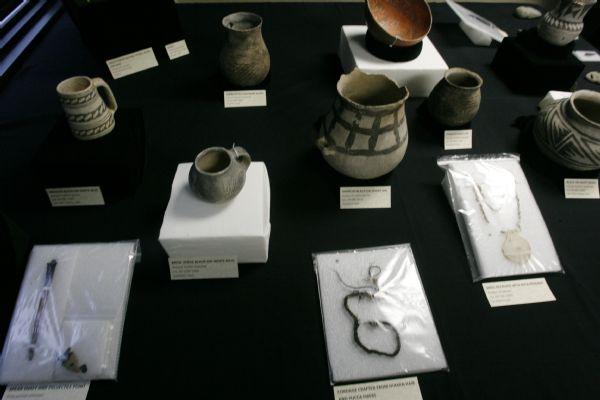This is an archived article that was published on sltrib.com in 2009, and information in the article may be outdated. It is provided only for personal research purposes and may not be reprinted.
A second defendant in the federal crackdown on archaeological looting in southern Utah has killed himself.
Steven L. Shrader, 56, who faced two felonies in the antiquities case, shot himself twice in the chest late Thursday or early Friday behind an elementary school in the village of Shabbona, Ill., authorities said.
The DeKalb County Sheriff's Office had been looking for a "despondent individual" after receiving a call Thursday at 10:41 p.m., said Chief Deputy Kevin Hickey.
Deputies launched a search with tracking dogs and found Shrader about 1 a.m. Flown by helicopter to a hospital in Rockford, Ill., he was pronounced dead Friday at 2:18 a.m.
Shrader, a resident of Santa Fe, N.M., was among 24 people indicted after a 2 ½-year investigation of illegal trafficking of American Indian artifacts taken from public and tribal land in southeastern Utah.
On June 10, federal agents simultaneously served warrants and arrested 19 residents of San Juan County and Moab. Shrader was one of five others also charged in the sweep.
The next day, Blanding doctor James Redd, charged with one felony in the case, took his life while sitting in his vehicle by a pond on his property. He died of carbon-monoxide poisoning.
Winnebago County, Ill., Coroner Sue Fiduccia said Shrader was in Illinois to visit his mother. Fiduccia also said Shrader had left a note. Hickey said the contents of the note would not be disclosed.
News of a second death in the antiquities crackdown surprised southeastern Utahns, although those contacted said they had not heard of Shrader.
"That's tragic -- if it's the result of his concerns over his case," said Phil Mueller, a Blanding resident and Redd family friend. "I don't know -- I don't know [Shrader]. But to hear the news is certainly very tragic."
Mueller added that he doesn't accept federal authorities' explanation that they needed a show of force in the raid because they believed most of the suspects could be armed.
"You could walk up to any house in San Juan County," he said, "and they'd probably have a gun."
Reached at her home in Shabbona, Shrader's mother, Iola Shrader, said she "can't talk" and that she was alone.
A neighbor said word had spread Friday and darkened the mood in her small town, especially because Shrader died on school grounds. The school is on the edge of town, near an expanse of cornfields, and close to the Shrader home, she said. She said she heard the shots Thursday around 10:45 p.m.
The neighbor, who asked not to be identified, said she did not know the family well. She hadn't noticed any visitors to the home Friday.
Shrader turned himself in last Friday at the FBI offices in Santa Fe and was taken into custody on a federal warrant, said FBI Special Agent in Charge Timothy Fuhrman of the Salt Lake City office.
Shrader was released after an initial appearance Monday in federal court in Albuquerque. Federal agents took him back to Santa Fe that day. His residence was not the subject of any of the search warrants executed by the FBI and Bureau of Land Management. He was scheduled to make an initial appearance in Salt Lake City on Friday morning, Fuhrman said.
U.S. Attorney for Utah Brett Tolman said that during the sting, an undercover operative bought and sold more than 250 artifacts from the Four Corners area, including sacred prayer sticks, baby blankets, seed jars and other objects included in ancient Puebloan burial mounds.
Shrader was indicted for allegedly trafficking in stolen artifacts -- specifically ancient sandals and a basket -- along with Carl "Vern" Crites, 74, Marie Crites, 68, and Richard Bourret, 59, all of Durango, Colo.
An affidavit filed in U.S. District Court in Denver implicates Shrader in a 2008 "arrowhead hunt" in Disappointment Valley near Dove Creek, Colo. The affidavit says an undercover operative, identified only as the "Source," was in the Crites residence in March 2008, when Vern Crites displayed arrowheads he said came from Disappointment Valley, a huge area ringed by prehistoric ruins.
During a subsequent conversation with the Source, Shrader said he had gone to the valley with Crites. It was unclear from court papers whether he was on public land.
Reached at his home in Durango, Vern Crites questioned the accusations against Shrader.
"I don't know why he was charged even," Crites said. "I don't think he did anything wrong."
Crites lamented the loss. "That's a shock to me, because he was a friend," he said. "He was a good young man, a single man, a hard-working man, very personable."
Crites declined to further discuss his relationship with Shrader.
New court papers offer a grisly glimpse at how alleged artifact hunters pillaged ancient burial sites and trafficked in items sacred to native cultures. One, after finding a skull, allegedly said, "[I] wished that fella had still been intact, the skeleton, I mean." > A4
Steven Shrader is the second defendant in the largest crackdown on illegal antiquity trafficking to take his own life. Utahn James Redd committed suicide last week. Twenty-two others face charges for allegedly looting public and tribal lands in the Four Corners area.



